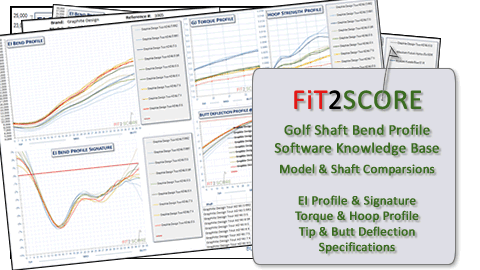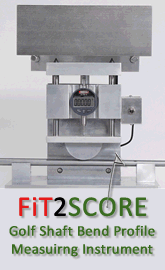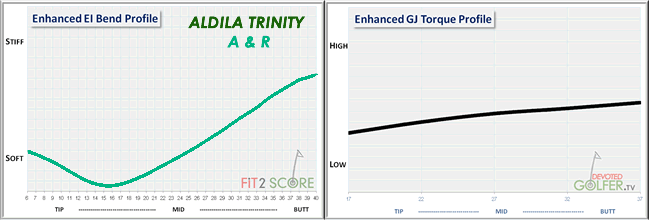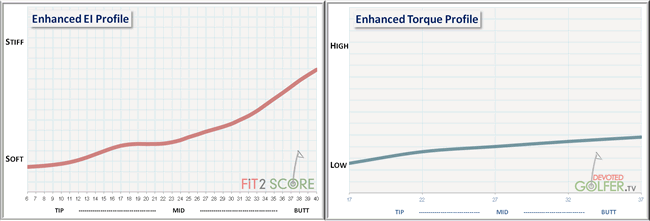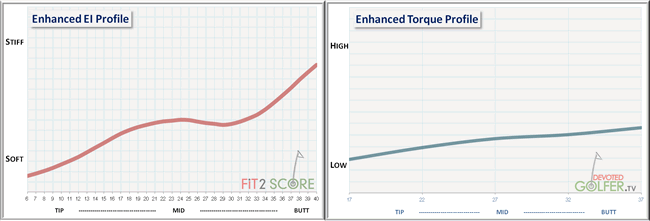ALDILA RIP
The Aldila RIP was introduced to the golf consumer in 2010. RIP stands for reverse interlaminar placement. Meaning, some of the bias plies that create torque were moved from the placement near the mandral to the outside of the shaft walls. The longitudinal plies, that create stiffness were sandwiched between the bias plies. This reconfiguration increased torque and hoop strength, creating a more stable shaft with a different feel.
The profile is a change from the Aldila NV, like many of today’s designs, it shows multiple hinge points. It is one of the few shafts that lose stiffness toward the tip will holding low torque. The 70g version is a good shaft for creating mid to high launch fairways.
With the introduction of the RIP line of shafts, Aldila began putting torque numbers on the label. With the 60 gram versions we found the torque numbers a little higher than our system, while the 70 gram versions we quite similar to our measurements. The radial profiles are very good, the shafts can be installed in any orientation.
The RIP comes in three versions. A Greek letter on the shaft indicates the version. The color of the eyes in the logo changes on each version.
Aldila RIP Alpha

The RIP Alpha, has red eyes. The Aldila RIP profiles are different in the 60g and the 70g models as shown. The radial profiles are very good, the shaft can be installed in any orientation. As you can see in the EI profiles, the shaft looses stiffness toward the tip. With shafts of this type, tipping will increase stiffness without changing the design intent of the shaft. When we see stiffness increases toward the tip, tipping can cut away some of the stiffest portion of the tip. That is not the case with the Aldila RIP design. We find the RIP to be mid launching shafts.
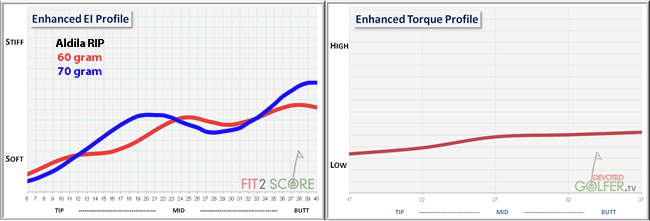
Aldila RIP Beta

This image shows the white version of the Aldila RIP. All of the Aldila RIP models are available in either white or black. In this photo, you can clearly see the Greek letter and the torque number in between the weight and stiffness. The Aldila RIP Beta, green eyes, has the same shaft geometry as the RIP Alpha from Butt to Mid. The tip is softer, yielding a higher launch and spin. In the heavier models, the Aldila RIP Beta is a great high launch low torque fairway shaft. The torque ranges from 4.9 in the 60R to 2.7 in the 70X Aldila RIP Beta, slightly higher than the Alpha. The profile does not change in the heavier models.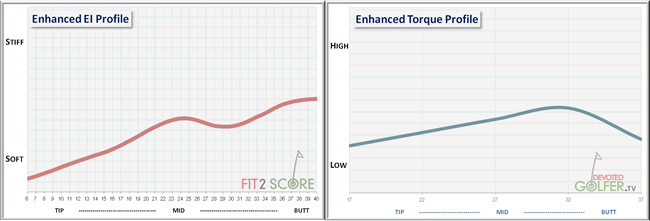
Aldila RIP Gamma

The Aldila RIP Gamma, yellow eyes, is a close match to the RIP Alpha. It is counterweighted. The balance point is about an inch and a half closer to the butt. This allows those that rely on swing weight to create a driver with a heavier head and still have a D2 swing weight. For those clubmakers that have moved on to MOI balancing this seems a bit archaic. It can be seen as a reminder of the weakness of the swing weight system. If you are looking for a counterweighted RIP Alpha, the RIP Gamma is just that. Or, you can do what Jack Nicklaus is reported to have done, and put a little lead tape under your grips. Many golf professionals have not been exposed to MOI balanced clubs and rely on a 90 year old scale design for club balance. Tradition runs strong in golf and the RIP Gamma caters to that tradition.
Aldila RIP Sigma
Aldila RIP Sigma is an OEM design. The samples tested were designed for Tour Exotic Fairways. The premium after market Adila RIP Alpha 70g X flex has a 2.6 torque while the ‘designed for’ version is 4.2. Based on limited samples the design is a hybrid of the Alpha and Beta. This is one more example of product compromises made to achieve price points that the golf consumer considers competitive and reasonable. In defense of the club companies, they simply deliver what the consumer is willing to pay for. Branded shafts in branded clubs, often sold for less than the price of the premium aftermarket shaft that gets played on tour, do not have the same manufacturing specs or tolerances as the tour quality shaft.




